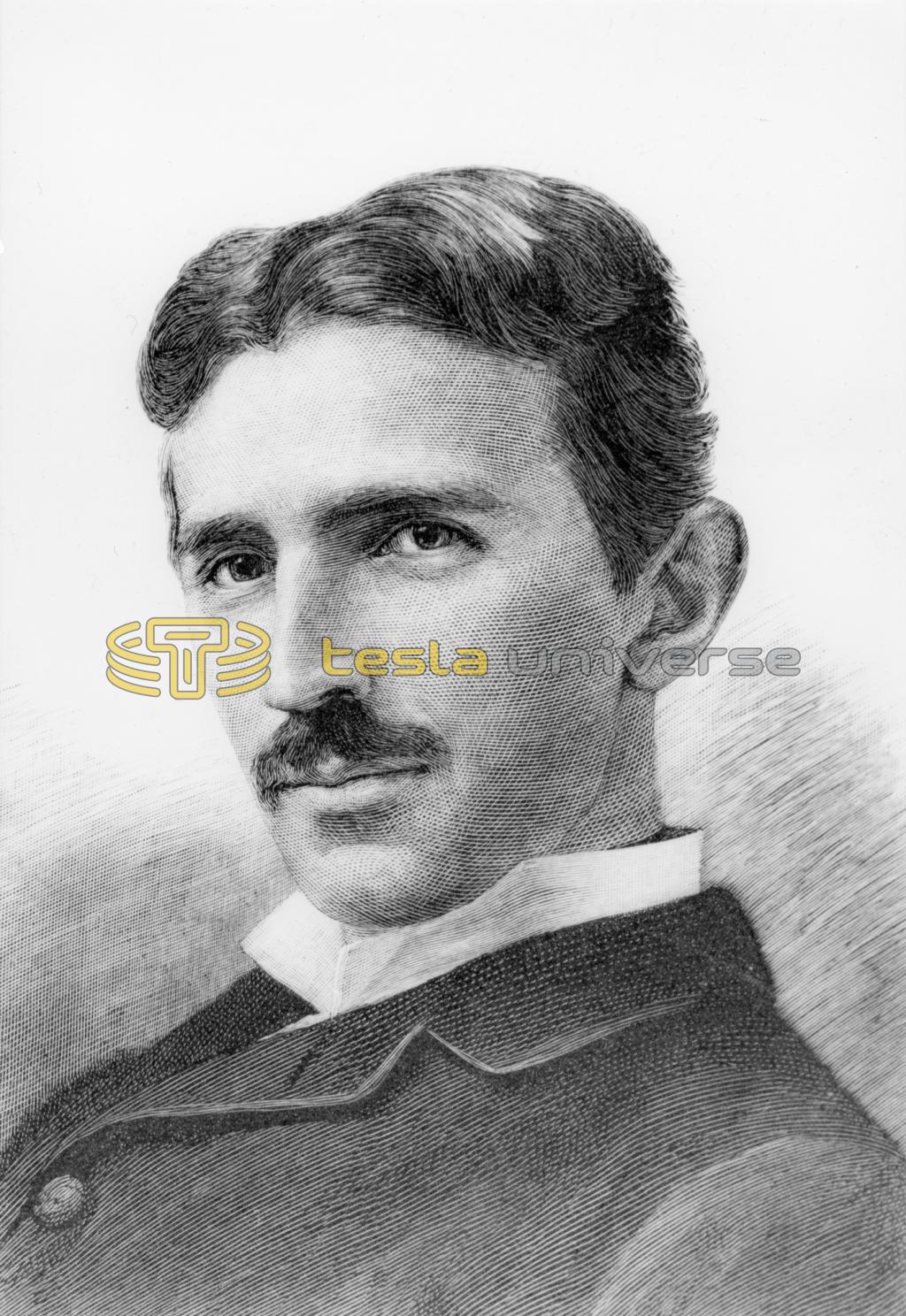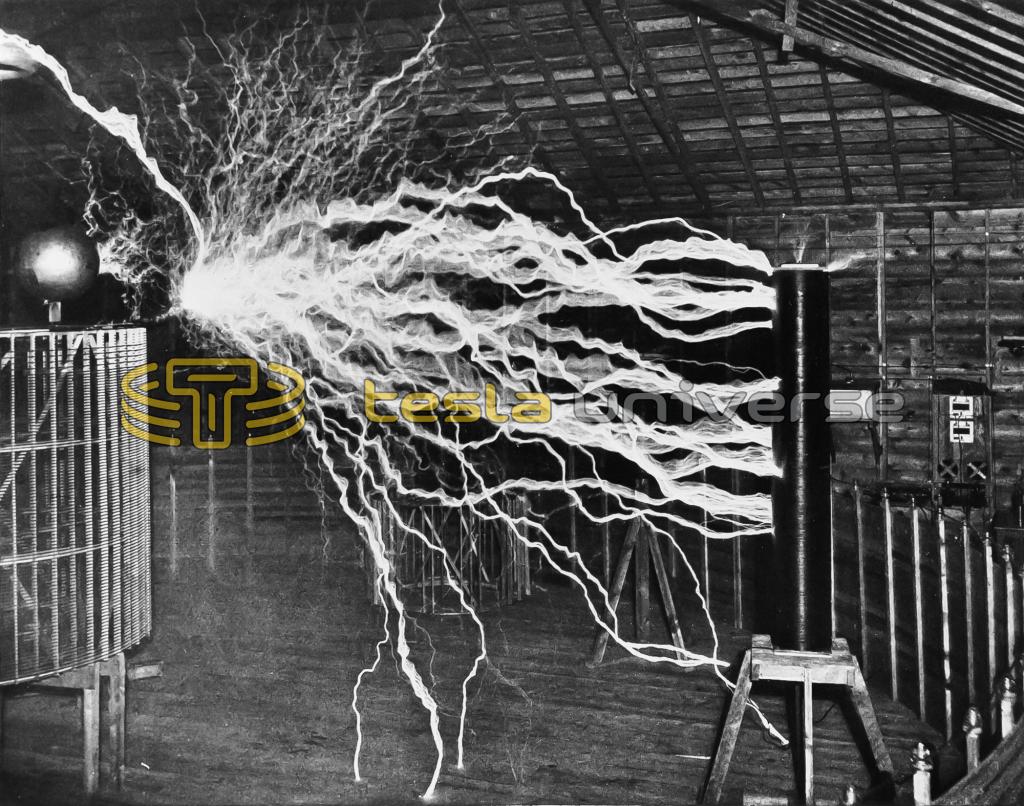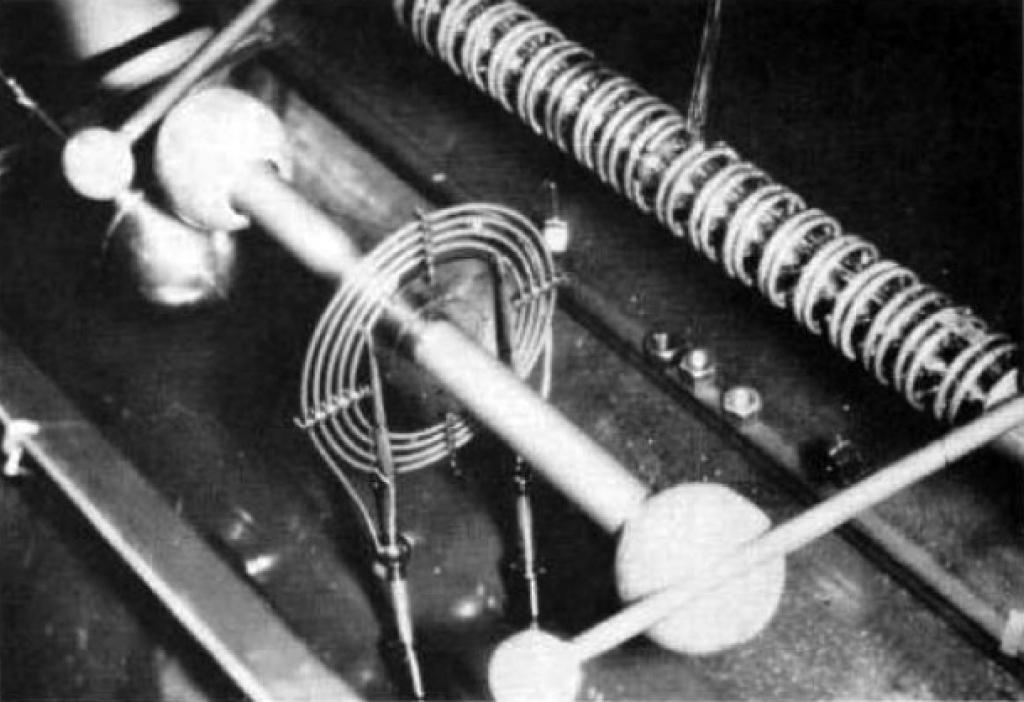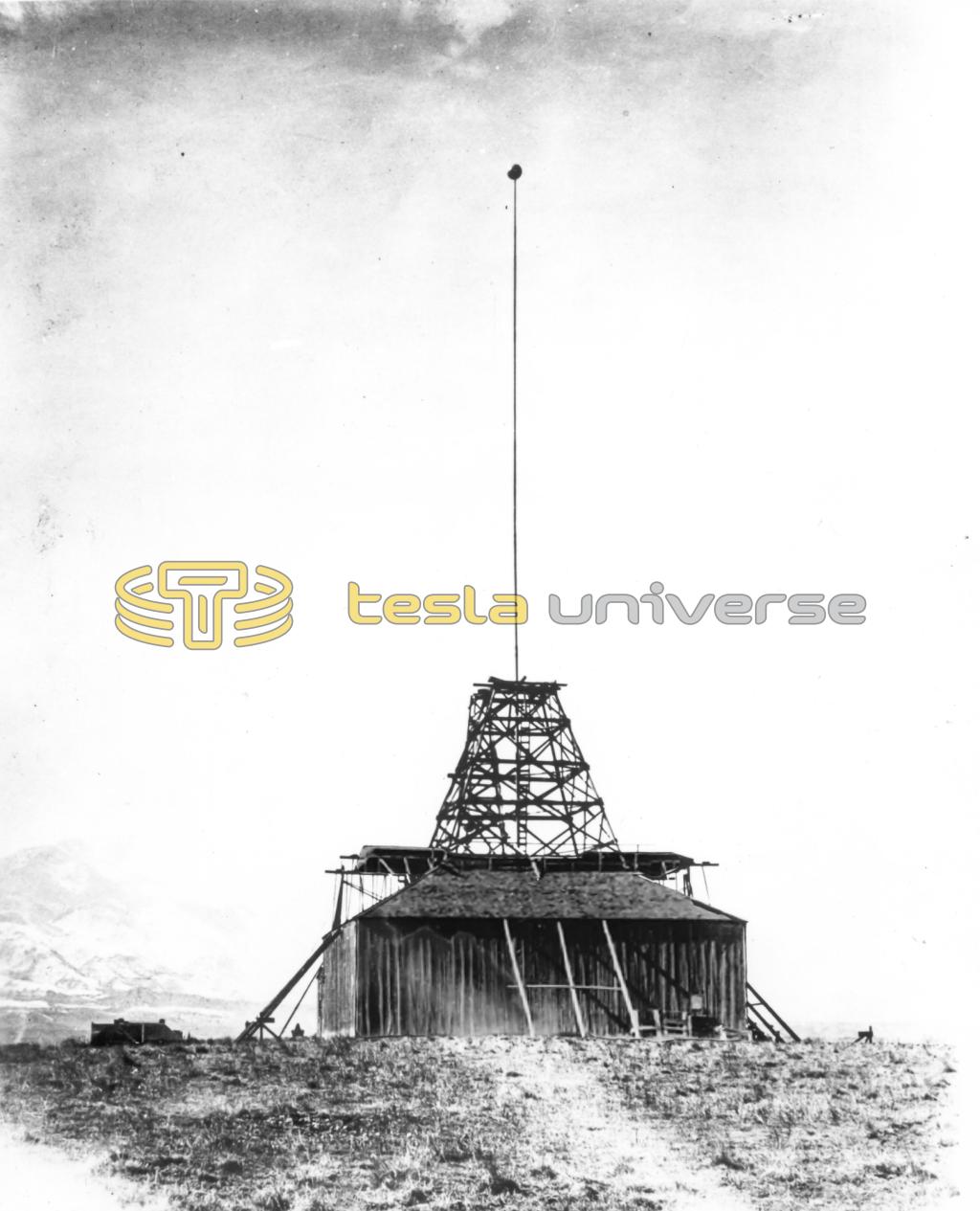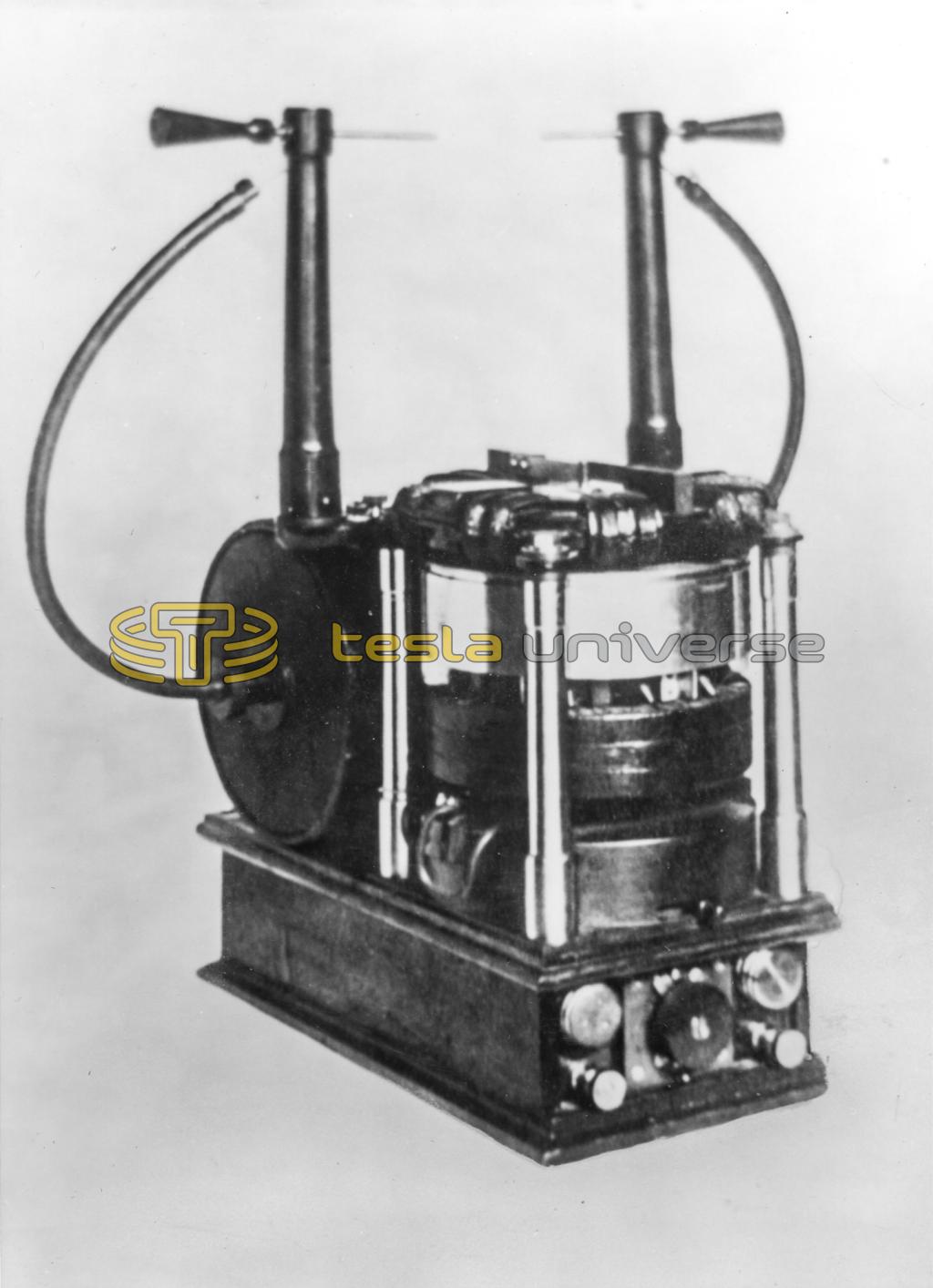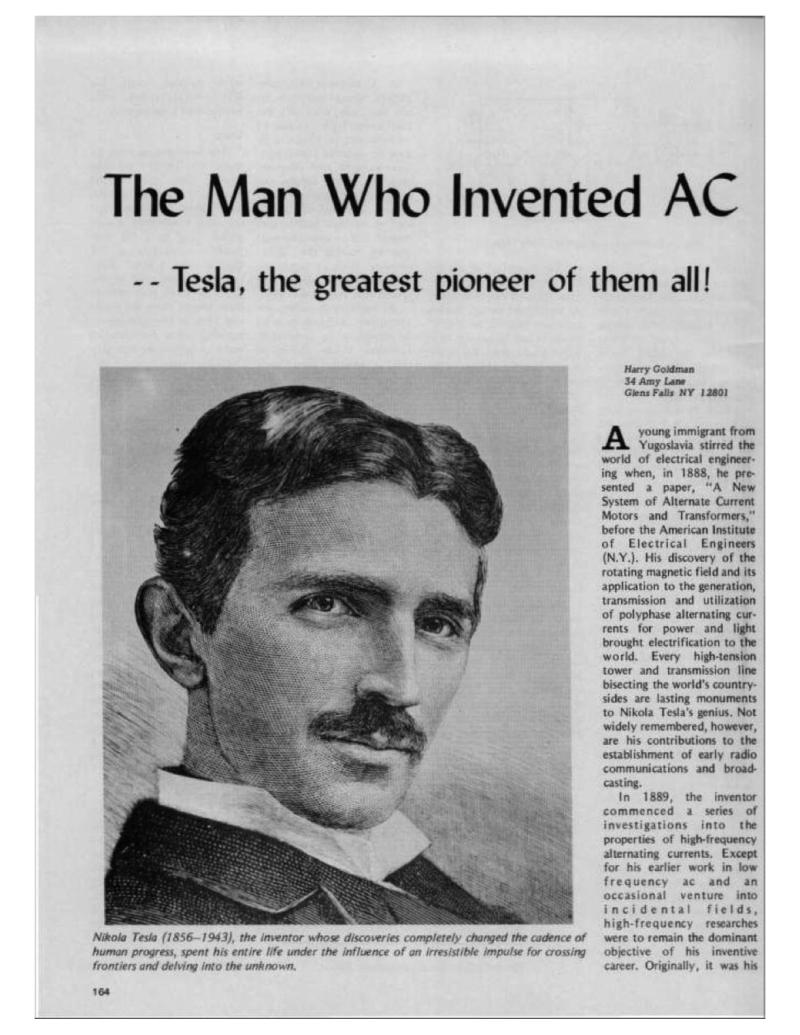
Nikola Tesla Articles
The Man Who Invented AC
Tesla, the greatest pioneer of them all!
A young immigrant from Yugoslavia stirred the world of electrical engineering when, in 1888, he presented a paper, “A New System of Alternate Current Motors and Transformers,” before the American Institute of Electrical Engineers (N.Y.). His discovery of the rotating magnetic field and its application to the generation, transmission and utilization of polyphase alternating currents for power and light brought electrification to the world. Every high-tension tower and transmission line bisecting the world's country-sides are lasting monuments to Nikola Tesla's genius. Not widely remembered, however, are his contributions to the establishment of early radio communications and broadcasting.
In 1889, the inventor commenced a series of investigations into the properties of high-frequency alternating currents. Except for his earlier work in low frequency ac and an occasional venture into incidental fields, high-frequency researches were to remain the dominant objective of his inventive career. Originally, it was his ambition to utilize these currents in developing a more efficient system of lighting. Shortly thereafter, Tesla inaugurated experiments which were to place him on a trail leading to communications, a goal which eventually evolved into an obsession.
Although it is not clear what force motivated Tesla in this direction, his intense interest in radio was probably initiated as a result of Heinrich Hertz's experimental work. Finding inspiration in James Clerk MaxwelI's electromagnetic wave theory, Hertz was able to transmit, receive and measure radio waves. It is without question that Maxwell's mathematical treatise, “Electricity and Magnetism,” initially announced in 1864, and Hertz's “Electromagnetic Waves in Air and Their Reflections,” published in 1888, formed the genesis of radio engineering.
Although Tesla was among the earliest who foresaw the application of electromagnetic waves in point-to-point communications, he continuously contested the concept of radio transmission by Hertzian waves. He attributed communications between ground stations to earth conduction. Later, when challenged to explain transmissions between ground stations and airplanes, the inventor responded, “capacitor action.” Tesla rarely wavered in this debate and it is probable that his persistent inflexibility retarded, if not prevented, proper recognition for his contributions.
By 1890, he had constructed alternators capable of producing undamped waves at 30 kHz. Some twenty years later, the radio industry, then beginning its embryonic stage, found undamped waves highly desirable. As a result, the high-frequency alternator became a sophisticated piece of equipment, holding a position of great significance in radio transmissions until the advent of the high-power triode in 1922. As a striking example of its importance, it was possession of the Alexanderson alternator patents which gave RCA a nearly insuperable advantage in early global communications . Thus, Tesla's conception of employing continuous waves, and his design of apparatus for producing them, preceded the radio industry by at least two decades.
Tesla again aroused the attention of the scientific world in 1891 when he presented the first of a series of historic lectures revealing discoveries from experiments with radio frequencies. (1) Among these was the disclosure of a new kind of transformer. Better known as a “Tesla” coil, this device represented the first application of the oscillation transformer. The Tesla transformer provided a remarkable advancement in that it invoked the principle of inductively coupled tuned circuits. Consequently, in his initial approach to communications, Tesla stumbled upon another important facet, the principle of tuning. Time has not dimmed its importance.
In his final lecture of the “trio-series,” Tesla suggested a system of radio communications employing synchronized aerial-ground elements at the transmitting and receiving stations. (4) In view of this disclosure, it would seem that he was the first to conceive the idea of using transmitting and receiving antennas tuned to the same frequency. Therefore, by 1893, some four years before contemporaries had made equally significant contributions to the art, it appeared that Tesla possessed both the technology and ambition as well as the visionary powers necessary for bringing radio communications to its fruition. What impediment barred him from achieving the honor?
Tesla opened a new laboratory. By 1897, he had carried out investigations in the field of X-ray, studies of the dynamics of mechanical vibrations, the invention of electromechanical isosynchronous alternating current generators as well as experiments with radio-controlled devices. One of his important contributions of this period was a high-frequency patent containing the fundamental principles upon which the “four-tuned-circuit system” of radio transmission was to be founded. (6) Professor Adolph Slaby, Germany's leading authority in early communications, demonstrated an enthusiastic appreciation for Tesla's work. In declaring Tesla as the “Father of Wireless,” he wrote, “I have been engaged for some time in investigations in telegraphy without wires, which you have first announced in such a clear and precise manner in your 'inventions.' It will interest you as the father of this telegraphy ...” (7)
Restricted by the limits of his New York laboratory, Tesla left for Colorado Springs in 1899 to initiate experiments on a large scale. Communications was to be but one phase of his project. Another was the transmission of electricity without the use of power lines. He was of the conviction that resonant effects of huge magnitude would enable him to utilize the Earth as a conductor. “Not only was it practicable to send telegraphic messages to any distance without wires,” stated Tesla, “... but also to impress upon the entire globe the faint modulations of the human voice; far more still, to transmit power in unlimited amounts to any terrestrial distance and almost without loss.” (8)
There, in the shadows of Pike's Peak, he constructed a large barn-like laboratory. Extending through the roof was a 200-foot mast topped by a 3-foot copper ball. Within the mysterious construction was an array of apparatus reminiscent of a Jules Verne fantasy. It was Tesla's intention to employ the equipment in an attempt to alter the electrical charge of the Earth.
The concrete achievements of the Colorado adventure remain obscure. Except for a lecture, some scattered notes, and a few ambiguous articles, he never fully disclosed the outcome of the experiment. He announced the discovery of standing waves induced in the Earth's static charge by nature's lightning and was able to duplicate them by bringing about an immense resonant action. In an experiment which has not since been equaled, Tesla produced the longest point-to-point man-made lightning discharges (135 feet) with an absolute potential of 18 million volts and antenna currents of 1,100 Amperes. This, and his ability to operate Earth-connected motors and electric lamps at a distance of eighteen miles from the source of energy, must be recorded as remarkable feats of engineering.
Tesla demonstrated the vision of a true prophet when he suggested the employment of standing waves as a means for detecting the position and movement of distant objects. “... By their use ... we may determine the relative position or course of a moving object such as a vessel at sea ...” (9) It wasn't until just before World War II that radar, as foretold by Tesla, became a working reality.
The Long Island plant was never completed. The cost of the project exceeded the inventor's available funds. The greater part of Tesla's endeavors were financed by private sources. John Jacob Astor, J. P. Morgan and Thomas Fortune Ryan can be cited as the most influential of Tesla's creditors. In addition, a demonstration of the feasibility of the “World System” principle was hampered by the complexity of a recurring illness. The tower remained intact for many years. Shrouded in an atmosphere of mystery, it proved to be but a landmark in evidence of the bold dreamer who had passed that way. The late John J. O'Neill, New York Herald-Tribune Science Editor, provided a description of its demise in his biography Prodigal Genius, The Life of Nikola Tesla. “... Heavy charges of dynamite were necessary in order to topple it, and even then it remained intact on the ground like a fallen Martian out of Wells' War of the Worlds.”
In an objective which no other person had then dreamed possible, Tesla had visualized, and nearly created, broadcasting some twenty years preceding it’s eventuality. “Of course,” stated Edwin H. Armstrong, radio pioneer and inventor of FM “the instrumentalities for practicing broadcasting were not then in existence. Tesla was classed as a visionary and his prophecy was forgotten. What harsher terms might, with justice, be applied to many of us who helped produce the instrumentalities with which broadcasting was eventually accomplished! We applied them to point-to-point communications, failing completely to realize the significance of Tesla's words.” (10)
In addition to the major goals mentioned herein, Tesla made an infinite variety of contributions to communications that remain generally unknown. The most striking example is a patent describing an invention for controlling moving objects by radio waves. (11) With this invention, Tesla singularly ushered in the age of radio-guidance systems. “We shall be able ... to send a projectile at a much greater distance; it will not be limited in any way, weight or amount of explosive charge; we shall be able to submerge it at command, to arrest it in its flight and call it back, and to send it out again and explode it at will; and more than this, it will never make a miss…” (12) Spectacular demonstrations of his radio-controlled device were presented in a week-long display at Madison Square Garden (N.Y.) and again, later, in Chicago. But to Tesla, this was just the beginning. In a gesture true of his unlimited imaginative powers, he proposed radio-controlled robots capable of thinking for themselves. He coined them automatons. “... It will be able to follow a course laid out or to obey orders given far in advance; it will be capable of distinguishing between what it ought and what it ought not to do ...” (13) Tesla's utterances raised more than the eyebrow of the scientific world. Resulting protests surpassed the discontent of indignation. The significance of Tesla's words, however, becomes more apparent when we consider today's vast industry of self-thinking machines as well as the huge arsenal of radio-guidance missiles poised at their stations throughout the world. These devices are able to perform exactly as Tesla had predicted.
Among his incidental contributions to radio communications was the Tesla “ticker,” a device for making continuous waves audible. This apparatus was a vital part of the Paulsen Arc stations until the heterodyne beat-note system was introduced to radio engineering. Several forms of Tesla's high-frequency spark apparatus were utilized by early transmitting stations for many years. His radio patents advanced the quarter-wave principle as well as antennas in the form of a loop. And it was Tesla who pointed out the importance of oil as an insulating medium in high-voltage equipment and who suggested the use of insulated stranded wire, later called Litzendraht, in high-frequency circuits.
There should be little doubt concerning the inventor's faculties for establishing a communications system. Its reality, however, proved to be too great a task, both physically and economically, for the efforts of an individual. Had he been associated with talent similar to the likes of a David Sarnoff, that energetic personality who brought the “music box” (radio) into every home and who led the Radio Corporation of America to communications history, his objective might have been assured.
Fritz Lowenstein, an assistant in his high-voltage experiment, and who later produced some excellent work in radio communications, if given a chance, might have served Tesla to great advantage. Lee De Forest, an inventor whose contributions are well established in the glorious history of radio, pleaded to be taken in as a Tesla assistant. Without detracting from their brilliant work, it is known that the many successes of men such as Edison and Marconi resulted from their ability to attract the assistance of highly capable associates. Tesla, however, was unable by temperament to avail himself of this advantage. Essentially, he was a “loner” who stood aloof and out of reach of those with whom he mingled.
On December 12, 1901, while Tesla was constructing his 300,000 Watt Long Island broadcasting station, Guglielmo Marconi, with but a fraction of that power, scooped the scientific world by sending three dots from Poldhu, England, to Saint John's, Newfoundland. The scientific society hailed Marconi. Even Tesla sent a congratulatory note but it was quite evident that he had been struck a blow by Marconi's feat. A crushing defeat to Tesla's bid for radio immortality came about in 1915 when he battled Marconi over the fundamental issues upon which early radio had become established. The courts ruled against Tesla, a judgment which was to influence succeeding litigation as well as to provide Marconi the means with which to institute unmitigated assertions for the invention of radio.
In his book, Marconi, Orrin E. Dunlap, Jr., provides an interesting comment. “At the turn of the century it was remarked that it was difficult to invent anything basically new in radio, and still more difficult to invent anything which did not have some bearing on or had not been preceded by an invention of Nikola Tesla. In 1891, at Columbia University, Tesla demonstrated the principle of tuning. He obtained patents on tuned circuits and claimed more than 100 tuning inventions. Nevertheless, it is called Marconi wireless; not Tesla wireless.”
Be all that as it may, Tesla's part in the evolution of communications was not to be denied completely. In the October sessions of 1942 and 1943, the Supreme Court declared the Marconi “four-tuned-circuit” patent, his most vital contribution, invalid because of prior disclosure by Tesla, Stone and Lodge. (15)
In summation, we find in Nikola Tesla a personality possessing an experimental acuity and prophetic vision equaled by no more than a handful of colleagues and surpassed by none. That he contributed to the groundwork of radio communications is evident through an examination of his lectures, articles and inventions pertaining to the subject. Although once hailed as “Our Foremost Electrician ... Greater Even Than Edison,” Tesla's accomplishments have since faded from the indexes of printed matter. (16) Consequently, it is possible though not probable — for an engineering student to complete a formal education without having heard of Tesla.
In an evaluation of the inventor's contributions to radio engineering, L. P. Wheeler credits Tesla with the independent discovery of the principle of inductive coupling between the driving and working circuits, the importance of tuning both circuits, that is, the idea of an oscillation transformer, and the employment of the capacitance loaded open secondary circuit. He describes Tesla as “... an immensely energetic personality possessing great skill in ac techniques and great ingenuity in their utilization ... his earlier accomplishments ... together with the inspiration given to many through his public lectures, would seem to justify a place in the history of radio engineering not so very far below that due to his accomplishments in the field of low-frequency alternating currents.” (17)
References
- Nikola Tesla, "Experiments With Alternate Currents of Very High Frequency and Their Application to Methods of Artificial Illumination." A lecture before the American Institute of Electrical Engineers, N.Y., May 20, 1891.
- Nikola Tesla, "Experiments With Alternate Currents of High Frequency." A lecture before the Institute of Electrical Engineers, London, February, 1892.
- Nikola Tesla, "On Light and Other High Frequency Phenomena." A lecture before the Franklin Institute, Philadelphia, February 1893, and before the Electric Light Association, St. Louis, March, 1893.
- Ibid.
- Charles A. Dana, New York Sun, March 13, 1895.
- Nikola Tesla, "Method of Regulating Apparatus for Producing Currents of High Frequency," United States Patent 568,178, September 22, 1896.
- Professor Adolph Slaby in a letter to Tesla, December 1, 1898. Original in, Nikola Tesla Museum, Beograd, Yugoslavia.
- Nikola Tesla, "The Transmission of Electrical Energy Without Wires," The Electrical World and Engineer, March 5, 1904.
- Nikola Tesla, "The Problem of Increasing Human Energy," The Century Magazine, June 1900.
- Edwin H. Armstrong, "Tribute To Tesla," Scientific Monthly, April 1943.
- Nikola Tesla, "Method of and Apparatus for controlling Mechanism of Moving Vessels or Vehicles," United States Patent, 613,809, November 8,1898.
- Nikola Tesla, "Tesla And His Work," New York Sun, November 21, 1898.
- Nikola Tesla, "The Problem of Increasing Human Energy," The Century Magazine, June 1900.
- Personal communication from John Oliver Ashton, October 15, 1954.
- United States Reports, Marconi Wireless Telegraph Co. vs. United States, Volume 320, October terms of 1942/1943.
- Arthur Brisbane, "Our Foremost Electrician," The World (N.Y.), July 22,1894.
- L. P. Wheeler, "Tesla's Contribution To High Frequency," Electrical Engineering, New York, August 1943.
